Explore Al Rifai Mosque: History, Tombs & Legacy
Al Rifai Mosque is a marvelous specimen of the neo-Mamluk architecture in the center of Cairo, where the royal family of Egypt is buried. The famous mosque is located opposite the Sultan Hassan Mosque, and thus, it is an important place to visit by history enthusiasts and other travelers touring the Islamic Cairo. Explore its spiritual meaning, design, and heritage.
- Overview of Al Rifai Mosque
- History of Al Rifai Mosque
- Al Rifai Mosque's construction process
- Top reasons to travel to Al Rifai Mosque
- What you can explore inside Al Rifai Mosque
- Best time to visit
- How to get there
- Accommodation and dining near Al Rifai Mosque
- Tips to travel to Al Rifai Mosque
- FAQs about Al Rifai Mosque
- In conclusion
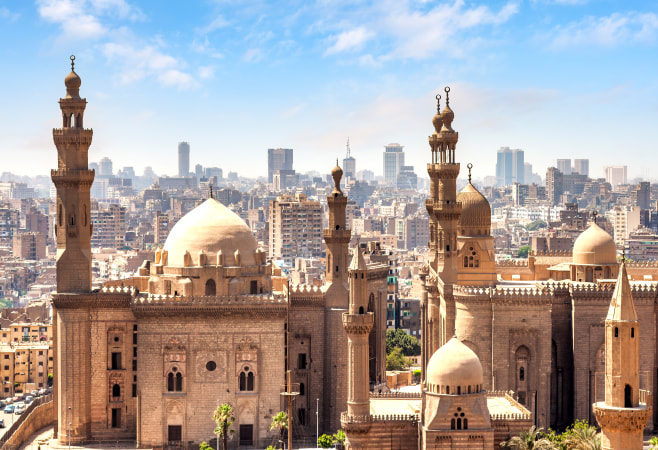
Uncover the beauty of Al Rifai Mosque
Overview of Al Rifai Mosque
Rifai Mosque is one of the most well-known examples of Islamic architecture in Cairo which is located at the Salah al-Din Square, opposite to the Sultan Hassan Mosque and near to the older Citadel of Saladin. It is also referred to as the Royal Mosque since it houses several Egyptian kings such as king Farouk and the ousted Shah of Iran.
The mosque is estimated to cover around 6,500 square meters, including approximately 1,700 square meters for the main prayer hall, while the rest comprises mausoleums and passageways. It was completed in 1912, 43 years after work had begun on it, it exhibits neo-Mamluk architecture with much in the way of decorative flourishes.
- Opening hours: 9:00 AM – 5:00 PM
- Entrance fee: EGP 220 (adults), EGP 110 (students) — includes access to Sultan Hassan Mosque.
History of Al Rifai Mosque
History of the Al Rifai Mosque the construction of this building was commissioned by Khushyar Hanim, mother of Khedive Ismail, in the year 1869 as a royal mausoleum. The initial plans were drawn by Egyptian engineer Hussein Fahmy Pasha. However, after multiple interruptions, the project was resumed and redesigned by Hungarian architect Max Herz Bey and Italian architect Carlo Virgilio Silvani, who incorporated the refined neo-Mamluk style seen today. She passed away in 1885 and was buried in the then-unfinished mosque.
Construction began in 1869, was halted several times, and resumed in 1905 under Abbas Helmy II, finally completing in 1912, with the Hungarian architect Max Herz Bey being brought in to finish the work. It opened the mosque to the people finally in 1912.
The construction of Al Rifai Mosque was done during the modernization period of Egypt in the 19th century where there was resurgence of Islamic architecture. It is in a neo-Mamluk style to reflect its historic contemporary, the Sultan Hassan Mosque, across the street.
In addition to its architectural value, the mosque acts as the resting place of the royal family of Egypt, the Khedive Ismail, King Fuad I, King Farouk I and the last Shah of Iran, Mohammad Reza Pahlavi.
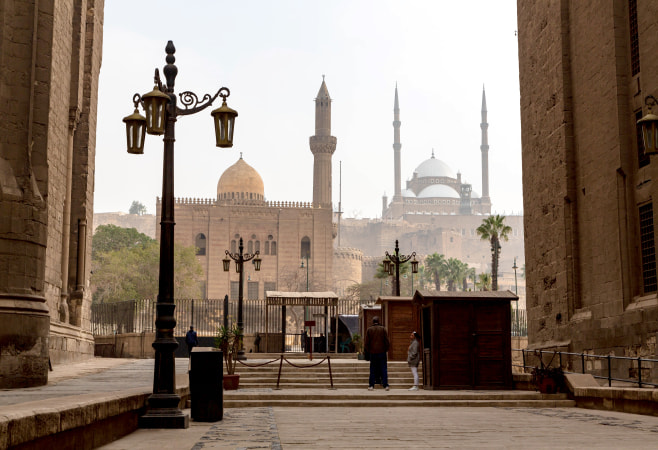
A look into Al Rifai Mosque’s history
If you're interested in discovering more about spiritual landmarks in the heart of the capital, take a look at this guide to a remarkable mosque in Egypt Cairo.
Al Rifai Mosque's construction process
Al Rifai Mosque was started in 1869 on the historic location of the Zawya of Al-Refai, in front of the 14th-century Sultan Hassan Mosque, in Citadel Square, Cairo. Khushyar Hanim, the mother of the Khedive Ismail, had it commissioned to use as a mosque, and as a royal family mausoleum of Egypt.
Its initial design was motivated by the neighboring Sultan Hassan Mosque, where it was planned to reflect its greatness and maintain the tradition of the Mamluk-style architecture. The first phase was headed by an Egyptian engineer Hussein Fahmy Pasha, who died early during the process. The project was again interrupted but then Abbas Helmy II revived it in 1905 with Hungarian architect Max Herz Bey and Italian architect Carlo Virgilio Silvani, under the supervision of Ali Pasha Mubarak.
In 1912, the construction of the mosque was finished after 43 years. Its four elaborately designed facades, domes, covered with gold and its Mamluk-style minaret were designed to show Islam traditions and the modernization ambitions of Egypt.
The mosque has seven different varieties of marble on its wall, brought in from seven countries and 44 columns with Quran verses engraved on them, making it extremely detailed. It became a symbol of dynastic legitimacy and cultural revival during Egypt’s modernization period under the Muhammad Ali Dynasty in the face of increasing European influence in 19th century Egypt.
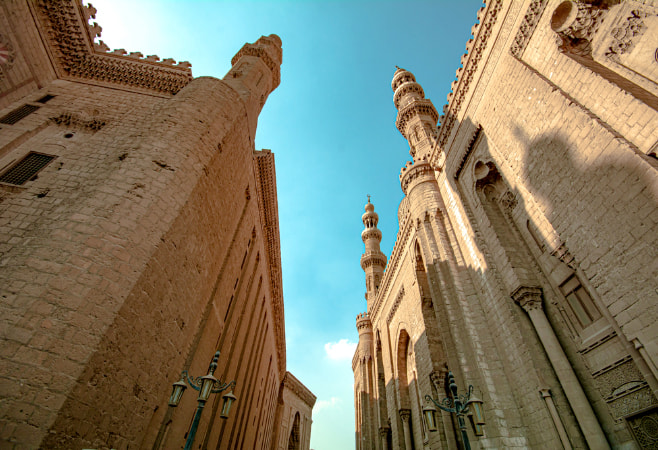
The building journey of Al Rifai Mosque
To further explore Cairo’s iconic Islamic architecture, don't miss the historic Al Azhar mosque Cairo Egypt, one of the oldest and most influential mosques in the Muslim world.
Top reasons to travel to Al Rifai Mosque
Al Rifai Mosque in Cairo will be liked by the travellers who are interested in history, culture and architecture. Here are the most convincing reasons why you should include it in your itinerary:
- Architectural beauty: This mosque is a combination of neo-Mamluk and Ottoman architecture, the richness of the domes, the minarets and the marble is highlighted.The mosque’s single minaret, along with its vast dome and ornate marble decoration, make it one of the most striking Islamic structures in Cairo.
- Great historical importance: It was constructed in 1869-1912, and it was now intended to be a royal mausoleum, and it represents Egyptian Islamic history and modernizing process.
- Royal tombs: It is a royal tomb of king Farouk I, Khedive Ismail, king Fuad I and even the final resting place of the last Shah of Iran, Mohammad Reza Pahlavi hence a local and an international tomb.
- Cultural and spiritual experience: The mosque is still a practical place of worship, and it can be fully used to have a thoughtful and relaxing place and a window into the Islamic tradition.
- Convenient place: It is situated close to the Cairo Citadel and opposite Sultan Hassan mosque thus very convenient to visit and it also has a variety of guided tours within the city.
Al Rifai Mosque is a full experience, spiritually, educationally as well as aesthetically, to anyone who visits the Islamic Cairo.
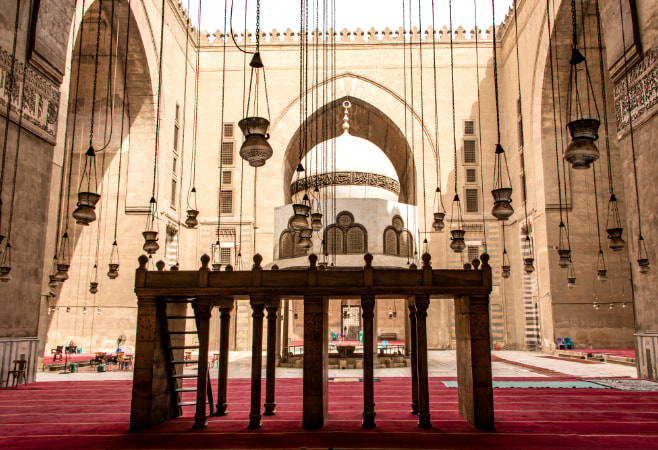
Must-see highlights of Al Rifai Mosque
For those interested in other sacred sites closely tied to Islamic heritage in Cairo, the revered Al Hussein mosque Egypt offers a profound spiritual and historical experience.
What you can explore inside Al Rifai Mosque
The Al Rifai Mosque is a cultural and historical site as well as a worshiping place. Once inside you can investigate:
- The main prayer hall: It is a large hall with high ceilings, richly decorated walls, and marble floors, and Quranic inscriptions.
- Royal Mausoleums: Tomb of the royal family of Egypt, Khedive Ismail, King Fuad I, King Farouk I and Princess Fawzia. Here you will also see the tomb of the former Shah of Iran, Mohammad Reza Pahlavi.
- Tomb of Sheikh Ali Abu Shubbak: According to local traditions, this is the tomb of a Sufi figure believed to be a descendant of Ahmad al-Rifa’i. While not officially documented in historical records, many visitors consider this site spiritually significant.
- Beautiful Islamic design: Seven-country marble, stained glass windows, gold and woodwork ornaments, and more than 40 huge columns engraved with golden verses of the Quran.
- Decorative domes and minarets: The main dome and two minarets are in neo-Mamluk style and they enhance the splendor of the interior.
A visit to the Al Rifai Mosque provides a very rich experience about Islamic art, the history of the kings and Egyptian culture.
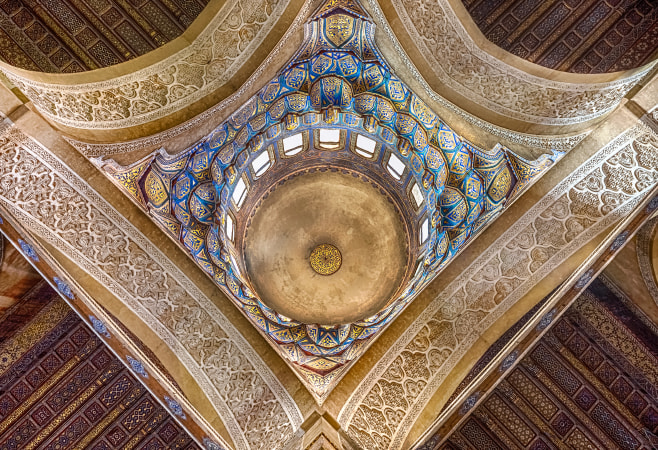
Highlights inside Al Rifai Mosque
Another architectural gem that reflects Egypt’s rich Islamic history is the iconic mosque of Muhammad Ali, located within the Citadel of Cairo.
Best time to visit
To make the most of your visit to Al Rifai Mosque, consider the following tips on timing:
- Seasonal weather:
- The most comfortable weather can be found in Spring (March-May) and Autumn (September-November), with mild temperature and reduced humidity. These are perfect periods to visit Cairo without bearing unbearable heat or swarms of tourists.
- Summer (June - August) is hot; take water, and go either very early or very late. Winter (December to February) is very mild but sometimes chilly days can be there.
- Days and hours: Open Sunday to Thursday, usually in the mornings until afternoon. Closed Friday mornings due to prayer services.
- Best time of day: Visit early in the morning to enjoy a peaceful atmosphere and cooler temperatures.
- Aim for shoulder seasons (spring or fall) to avoid peak tourist traffic.
Whether you're exploring for culture, history, or photography, planning your visit wisely ensures a more enjoyable experience.
To delve deeper into Cairo’s oldest surviving mosques, be sure to visit the remarkable Ibn Tulun mosque in Cairo, renowned for its unique architectural style and historical significance.
How to get there
The location of Al Rifai Mosque is Citadel Square, close to the Saladin Citadel and directly facing the Sultan Hassan Mosque. The best ways to arrive there are as follows:
- By Metro: Cairo Metro Line 1 to Saad Zaghloul Station. While it is the closest metro station, the mosque is about a 30-minute walk away. Due to the heat, it is highly recommended to take a short taxi or rideshare instead of walking.
- By Taxi: Taxis are very common in Cairo. Write or show the driver the name of the mosque which is Al Rifai Mosque near the Citadel in Arabic.
- By Bus: A number of buses pass through Tahrir Square (Abdel Moneim Riad stop) to the Citadel area. A little bit of Arabic is useful in case of traveling by public buses.
- Guided tour: Most of the tours around Cairo stop at Al Rifai Mosque, and transportation is provided.
- Walking: When your accommodations are in the vicinity of Downtown Cairo, then you could opt to walk to the mosque, particularly when you are also planning to visit other nearby attractions such as the Citadel.
It can be very helpful to have the location saved in a navigation app and use it to make your trip much easier.
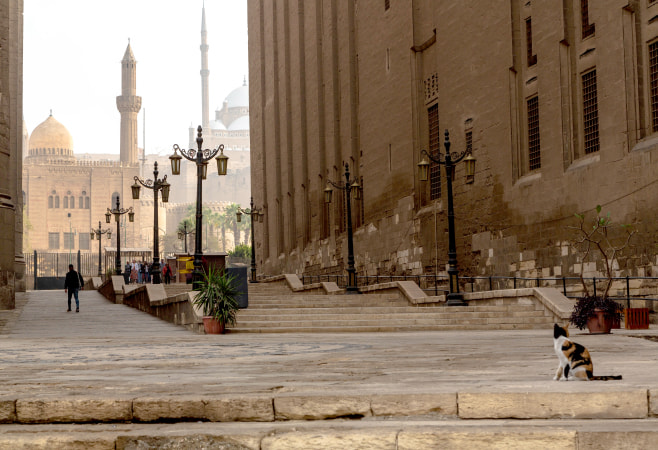
Ways to access Al Rifai Mosque
Accommodation and dining near Al Rifai Mosque
When visiting Al Rifai Mosque, there are several convenient accommodation and dining options nearby:
- Hotels: There are numerous hotels within the surrounding localities (Islamic Cairo and Downtown Cairo), varying in price and luxury, some overlooking the Citadel.
- Guesthouses & Hostels: Guesthouses are the best option to stay in Egypt if one is on a very tight budget as they offer very basic facilities and a more local experience.
- Vacation rentals: Vacation rentals such as Airbnb have apartments around the Citadel, which are suiting independent travelers.
- Places to eat: There are local Egyptian restaurants and casual dining places in and around the vicinity of the mosque and Citadel, offering kebabs, falafel, koshari and fresh juices.
- Luxury dining: For upscale meals, head to Zamalek or Garden City, just a short drive away.
Always check updated reviews and availability online for the best current options.
Tips to travel to Al Rifai Mosque
To make your visit to Al Rifai Mosque smooth and respectful, consider the following practical tips:
- Dress code: It is advised to wear loose clothes that cover knees and shoulders. Women are asked to bring an accessory that covers their hair, a headscarf.
- Remove shoes: Remove shoes before entering the prayer hall. Wearing socks is recommended.
- Respect the space: Remain silent, and do not disturb, and do not touch anything that is religious like the Quran.
- No eating or smoking: In the mosque, there is no eating or drinking and smoking.
- Photography: Always ask before clicking photos and especially in the places of worship.
- Entrance charge: The mosque typically is open on Sundays through Thursdays 9:00 AM 4:30 PM. One should avoid visiting on the day of Friday prayers.
- Take part in a guided tour: Mosques are available offering tours to help you have a better understanding of the architecture and royal history of the mosque.
- The second destination: Walk around in the local souq and purchase souvenirs and sample traditional Egyptian cuisine in the local restaurants.
FAQs about Al Rifai Mosque
Here are some frequently asked questions to help you learn more about the Al-Rifa'i Mosque.
Who is buried in Al-Rifa'i Mosque?
Khedive Isma'il Pasha, King Farouk of Egypt, and Reza Shah of Iran are buried in Al-Rifa'i Mosque, making it a royal mausoleum for Egyptian and Iranian monarchs.
Is photography allowed?
Photography is usually permitted in Al-Rifa'i Mosque in Cairo, yes, though it is advisable to be careful and not to use flash and not to take photos of worshippers praying. In the case of professional equipment, the consent of authorities can be needed.
What souvenirs can I buy?
The Al-Rifa'i Mosque does not have official souvenir shops. However, there are local souvenirs, such as Islamic calligraphy, miniature models of mosques, prayer beads (misbaha), traditional fabrics and handicrafts, which can be found in the local neighborhoods around the mosque. Outside the mosque or in the adjacent Khan El Khalili market, it is also possible to find small replicas of Egyptian monuments and decorative plates with mosque architecture.
In conclusion
In conclusion, Al-Rifa’i Mosque is a must-see destination in Cairo that beautifully combines history, architecture, and spiritual legacy that offers a unique opportunity to connect history, architecture, and spirituality. It is near the Citadel and it provides the visitors with a deep impression about the Islamic history in Egypt. And those travelers who would like to see this marvelous place should not have any problems with receiving an Egypt eVisa, which can be done by simply completing the application form on the official site of Egypt Immigration Service, and entering/leaving the country trouble-free.
Related Articles
- Business Visa Egypt – Requirements, Fees & How to Apply
- Student Visa Egypt Guide: Requirements, Fees & Process
- 5 Year Multiple Entry Visa Egypt: Full Guide & Updates
- How much is a visa from Nigeria to Egypt? Full cost guide
- Egypt Visa Extension: How to Apply, Requirements & Guide
- Egypt Transit Visa Guide: Requirements, Process & Tips











